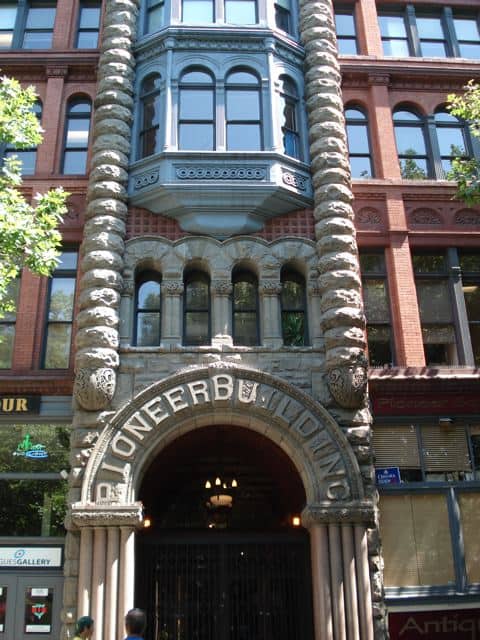Stories in Stone
 Pioneer Building with 50-million-year old sandstone from Bellingham, specifically from the Chuckanut quarries.
Pioneer Building with 50-million-year old sandstone from Bellingham, specifically from the Chuckanut quarries.
Guest post by David Williams
(David Williams is leading “Seattle’s Wild Side: Natural History in the Streets” tour on Saturday, Sept. 26. Sorry, the tour is full!)
As a hard-core geogeek, I often need a fix of rock. Since I cannot always get up into the mountains to check out our wonderful geology, I regularly head downtown in search of stone. This may seem odd but in Seattle I can find rock ranging in age from 3.5-billion-years old to less than 80,000 years old. I can touch rocks from places as diverse as South Africa, Germany, Italy, Brazil, and Finland, as well as Indiana, Minnesota, Washington, and California. I can gaze at fossils as big as a cinnamon roll and ones that resemble an ice cream cone. And if those fossils drive my hunger, I can even find those foods nearby, something I cannot do in the field.
I first became infatuated with building stone in the Metro bus tunnels. Under Westlake Mall I found a spectacular rock that looks like a marble cake. I later learned it was the oldest commonly used building stone in the world and that it was a popular building material during the period when Art Deco architecture was popular. As I began to look at stone in other buildings, I continued to find interesting connections between rock and people.
For example, when Seattle burned to the ground during its Great Fire of 1889, stone replaced wood as the main building material. You can see this in the older parts of the city around Pioneer Square where 50-million-year old sandstone quarried in Bellingham, Wilkeson, and Tenino and a 33-million-year old granite from Index make up many of the buildings. The stones were popular because they could easily be transported to Seattle and withstood erosion.
Following the fire, as city residents became wealthier they sought out stone from further and further away. Limestone from Indiana, serpentine from Vermont, and gneiss from Minnesota first appear in buildings in the late 1920s. Now, as noted above, stone arrives in Seattle from all over the world, which makes geologists such as myself quite giddy. These are some of the stories that I have written about over the years as an urban naturalist. I will tell a few more and lead us to some of my favorite stories in stone on my program.


Thanks for the post! It’s always good to be reminded that we don’t have to leave cities to exercise our naturalist skills. I had a lot of fun following you around Seattle on this class last year, and I hope you will all have a great time this year.